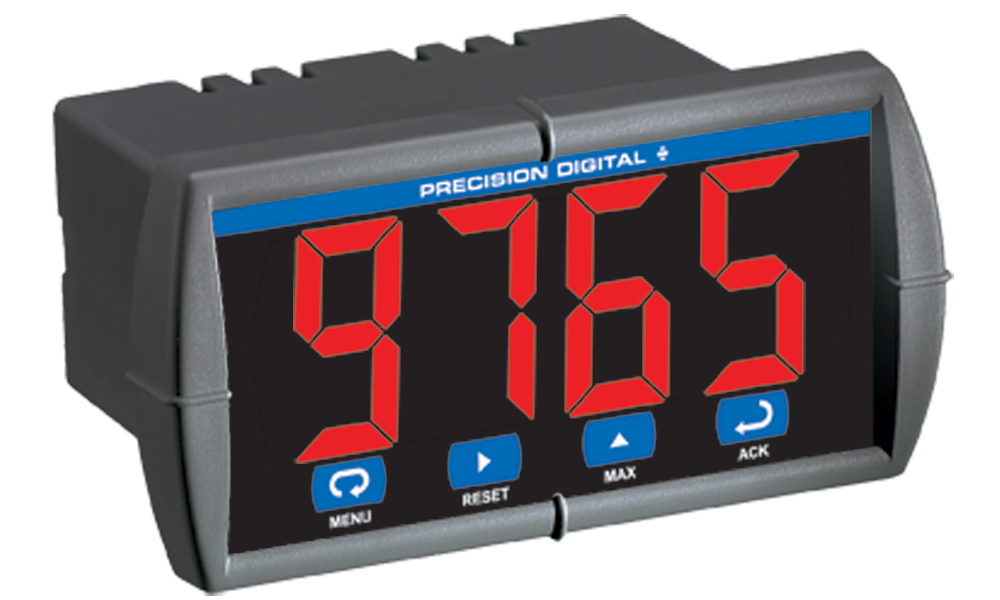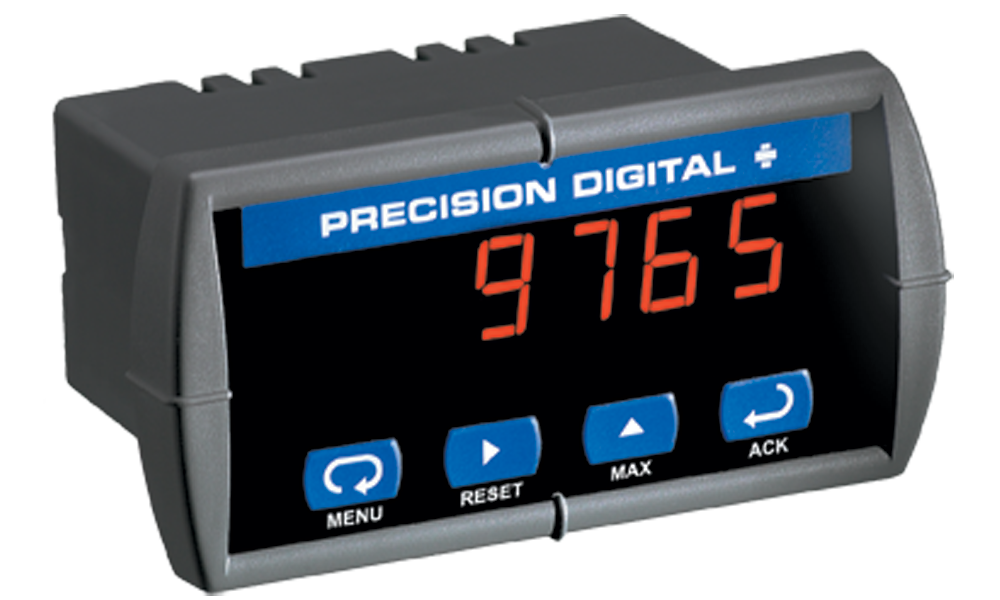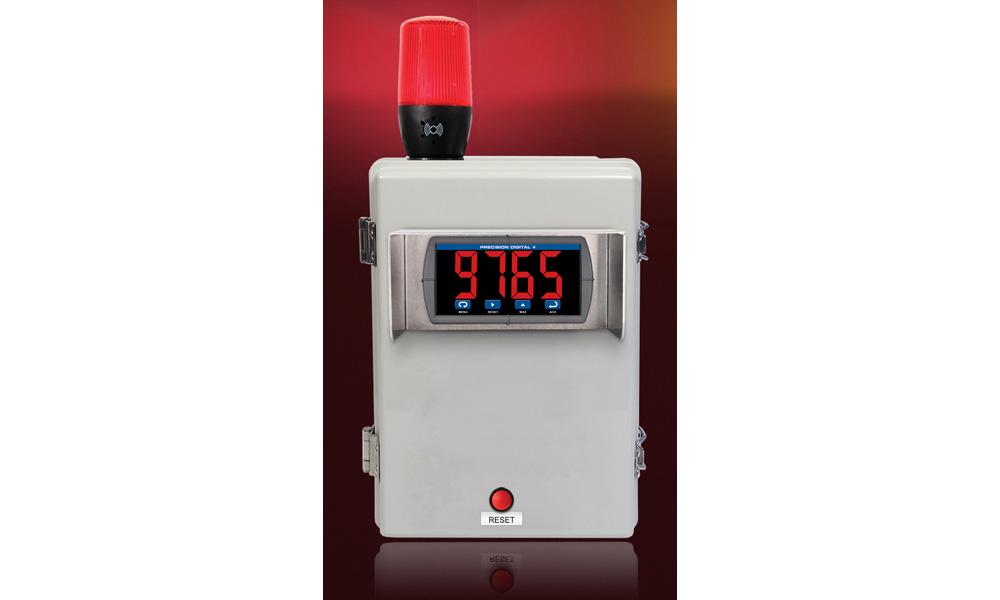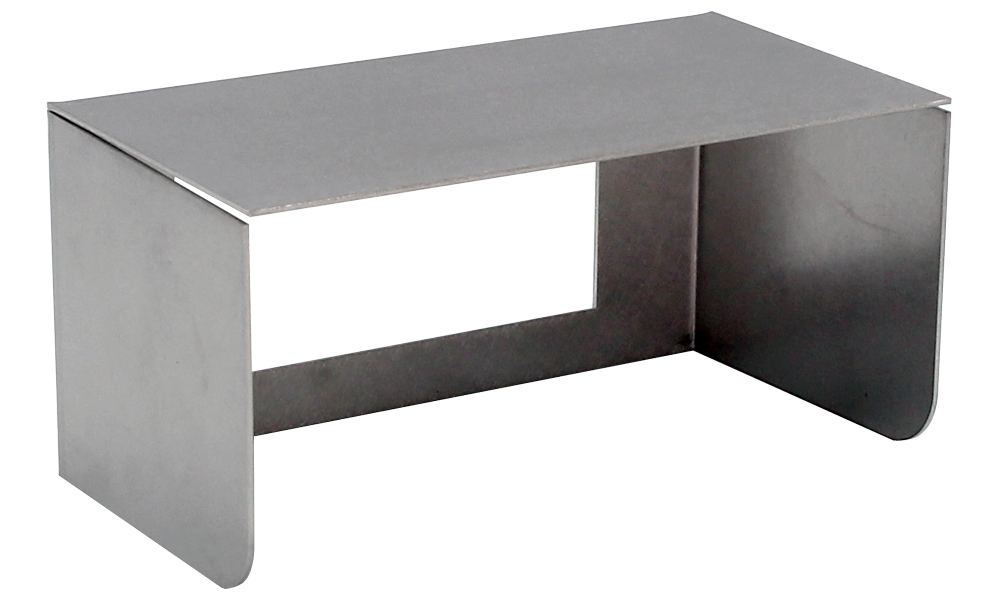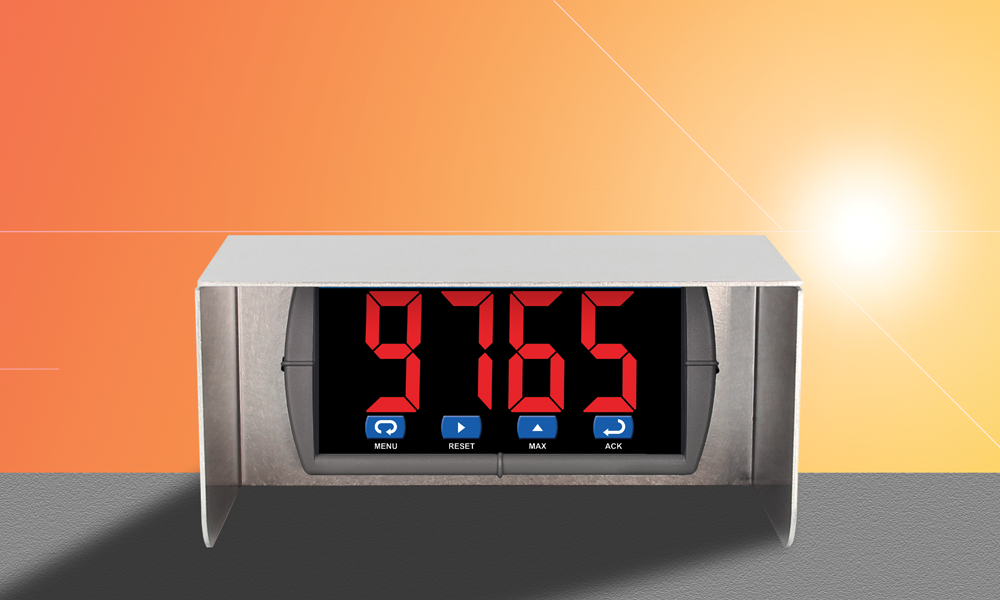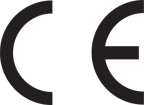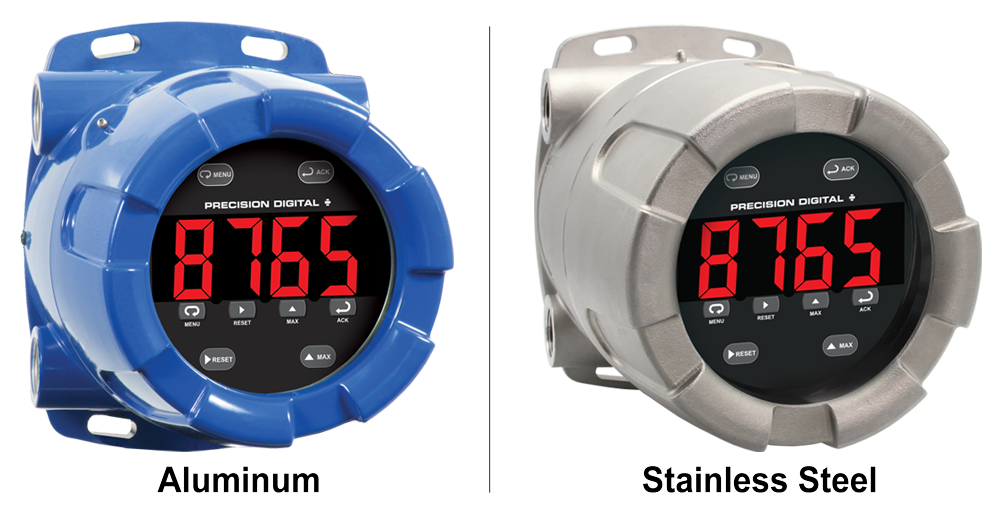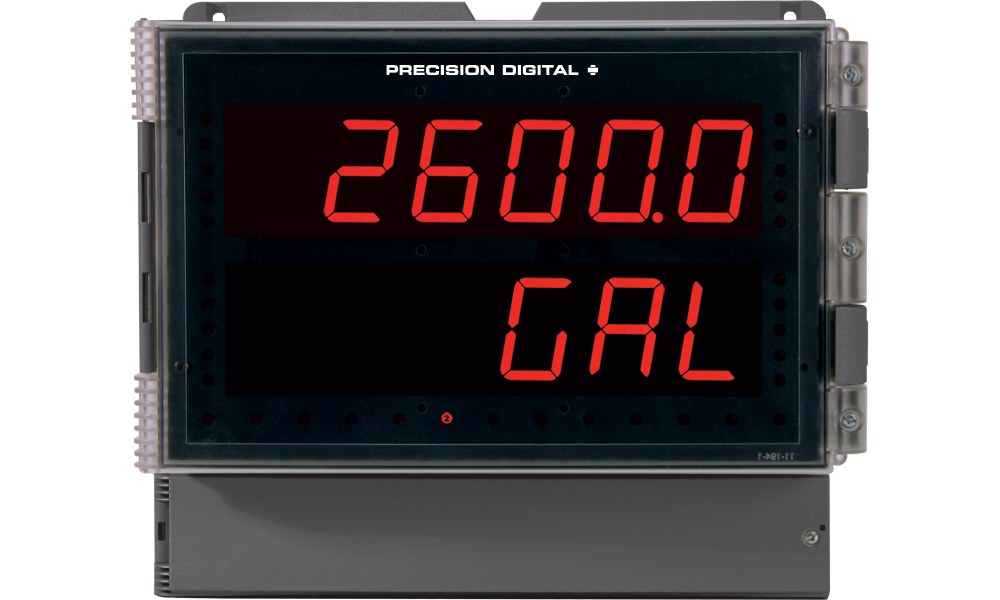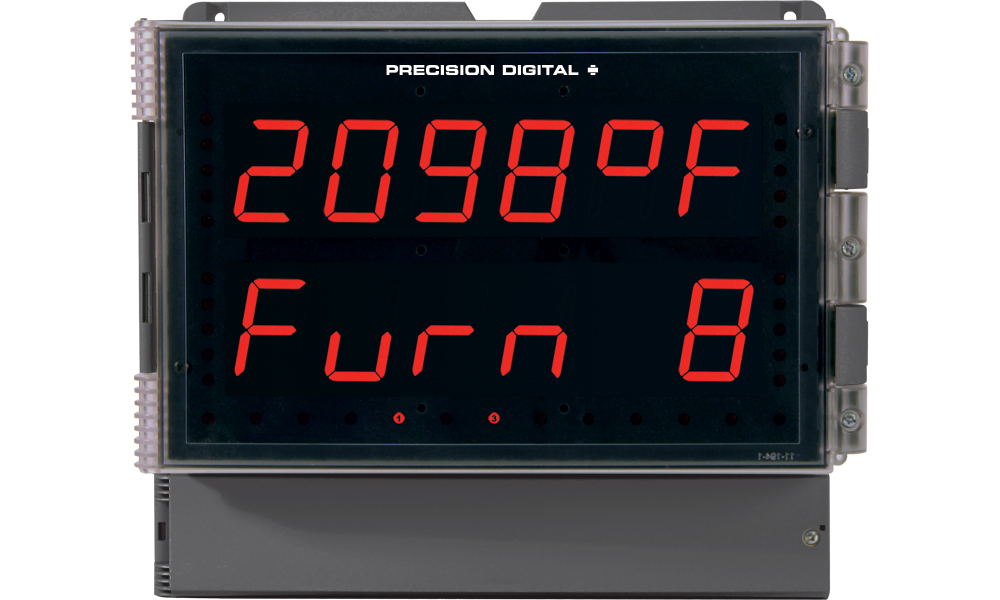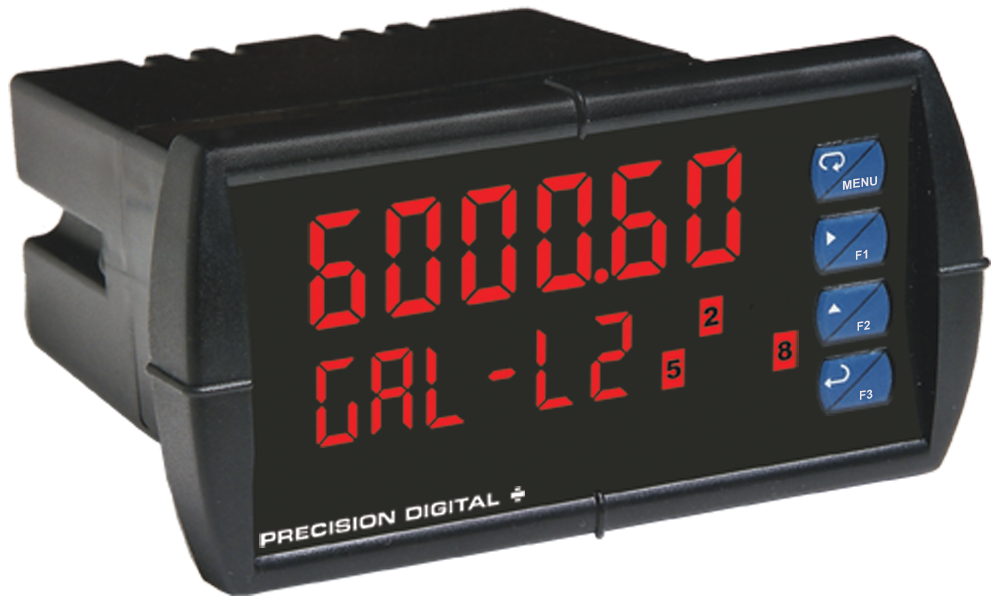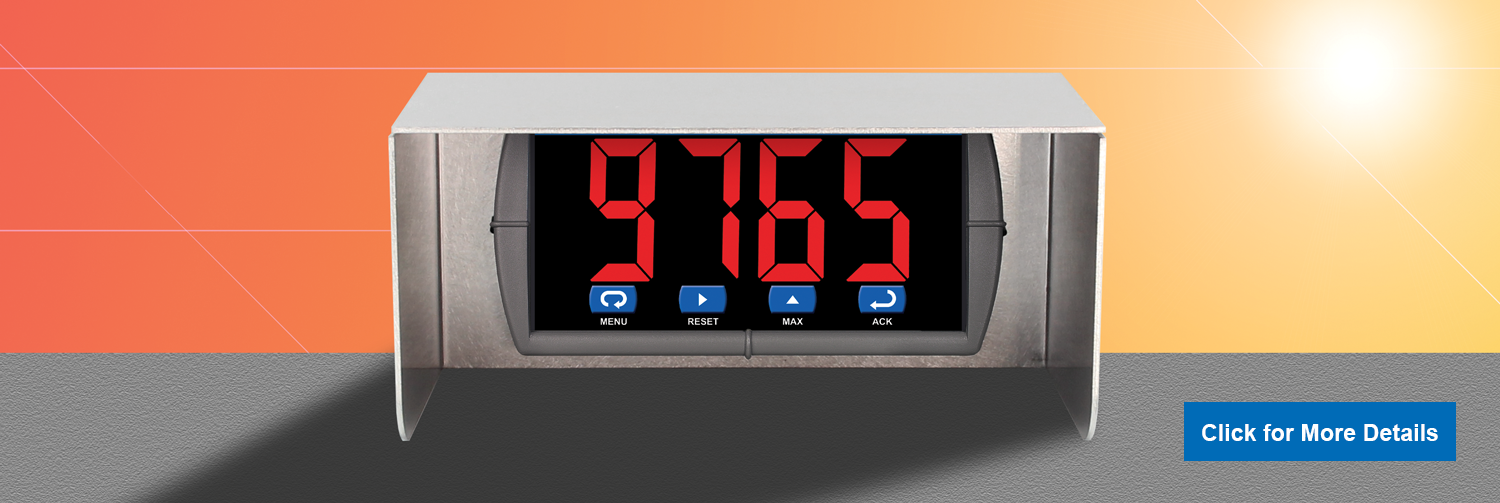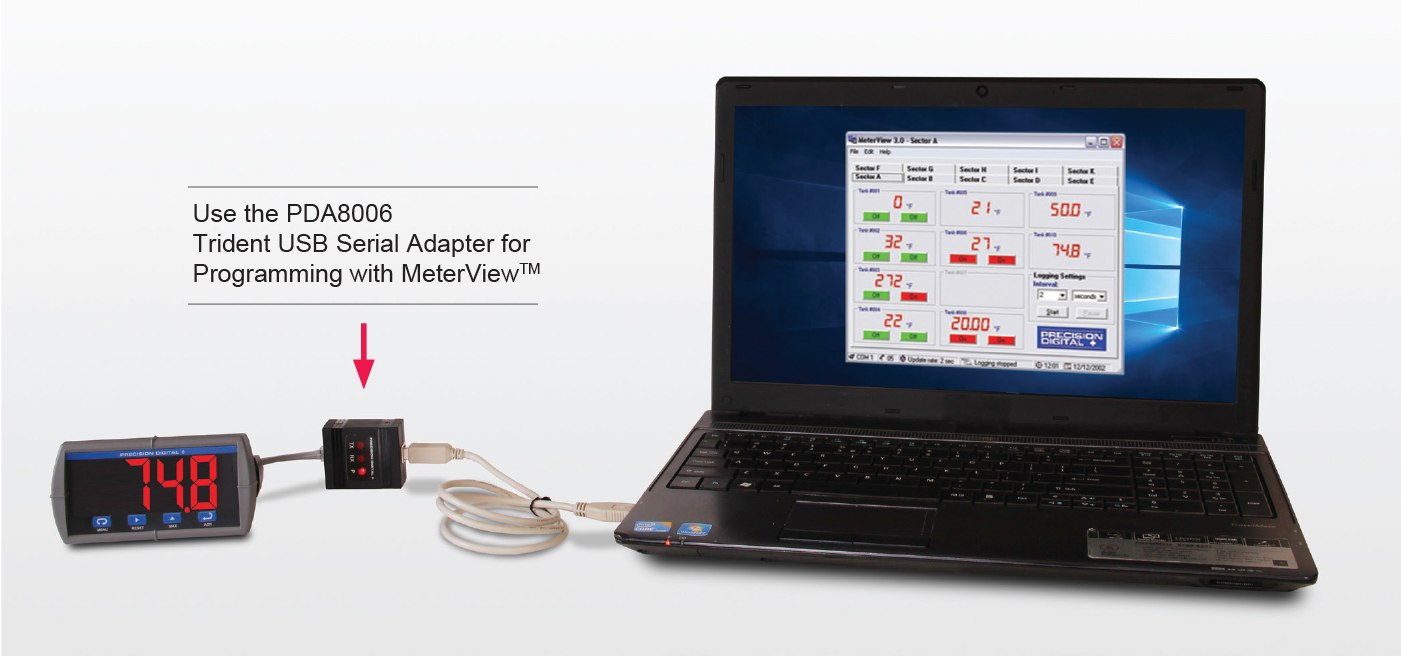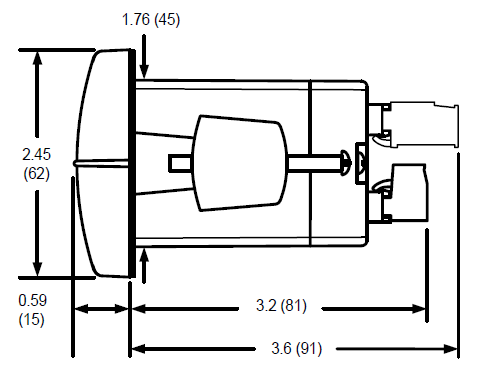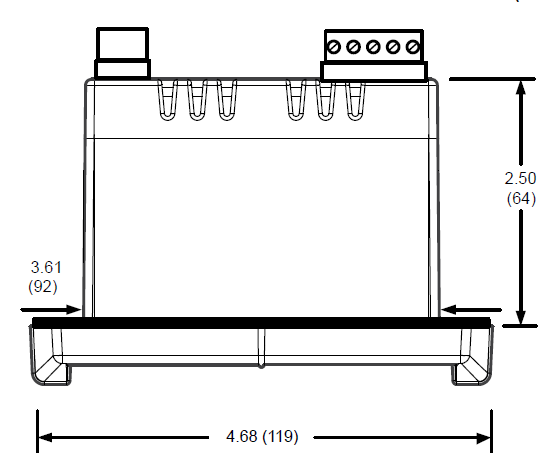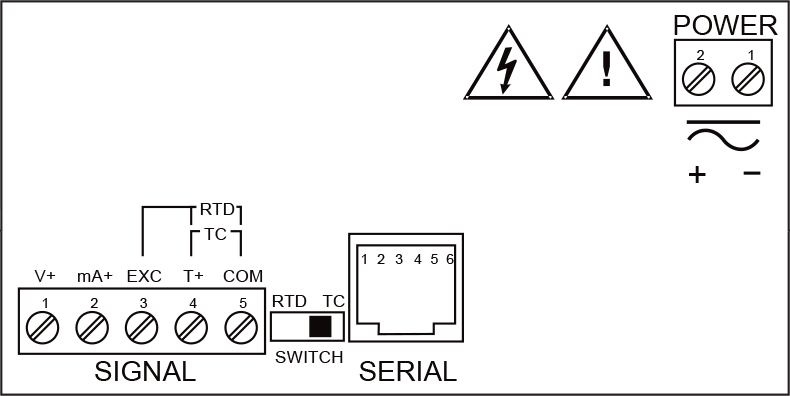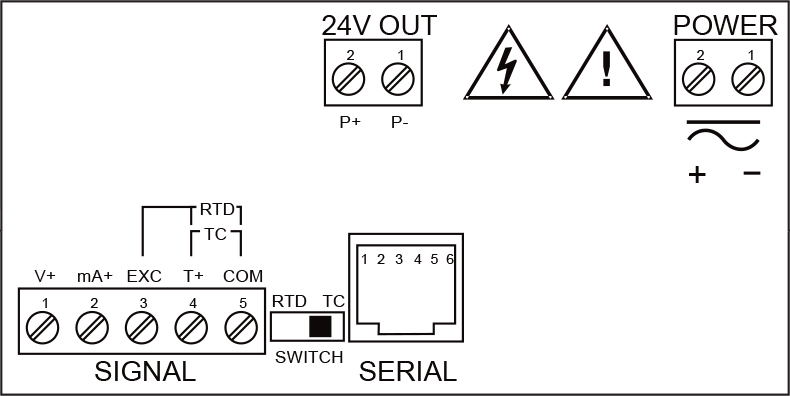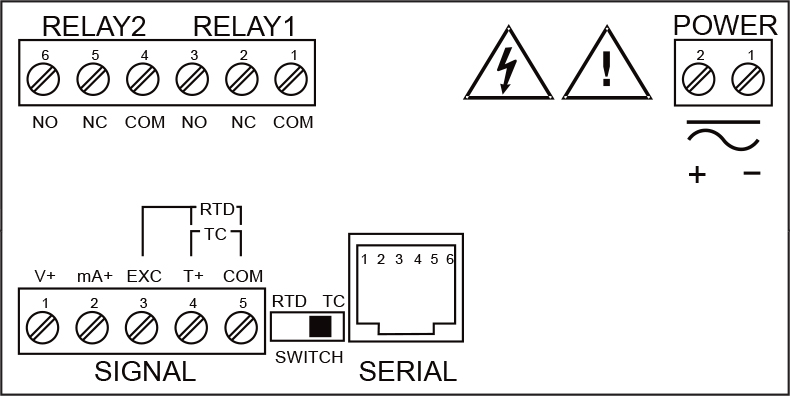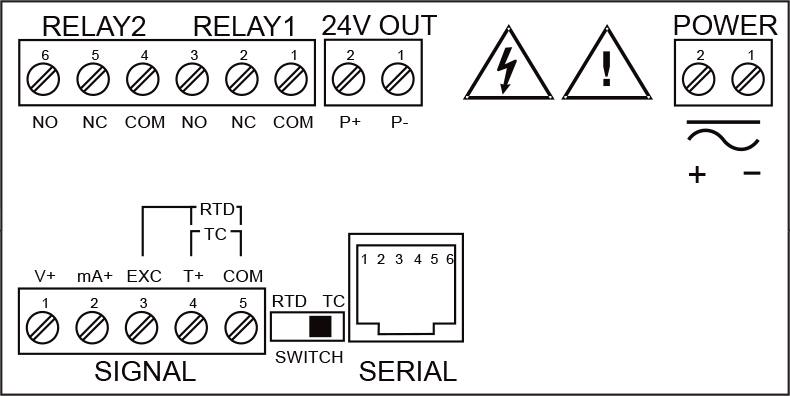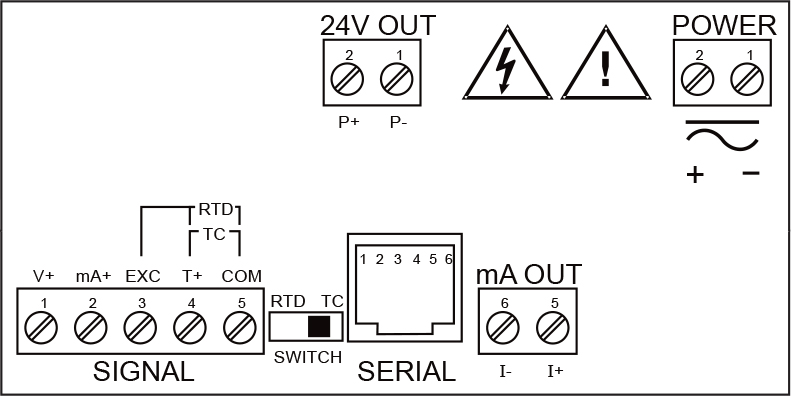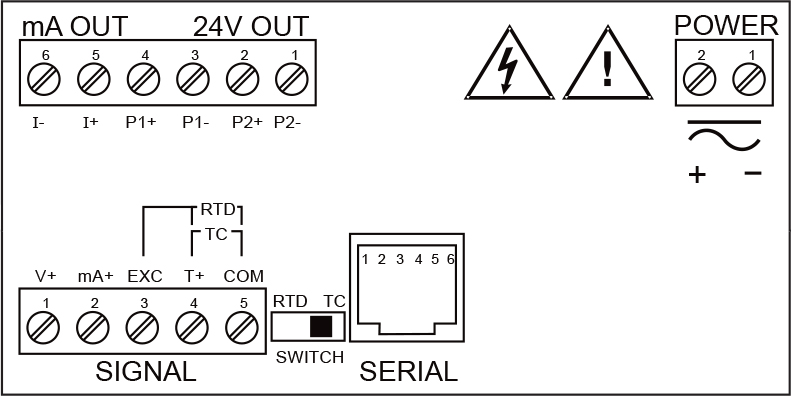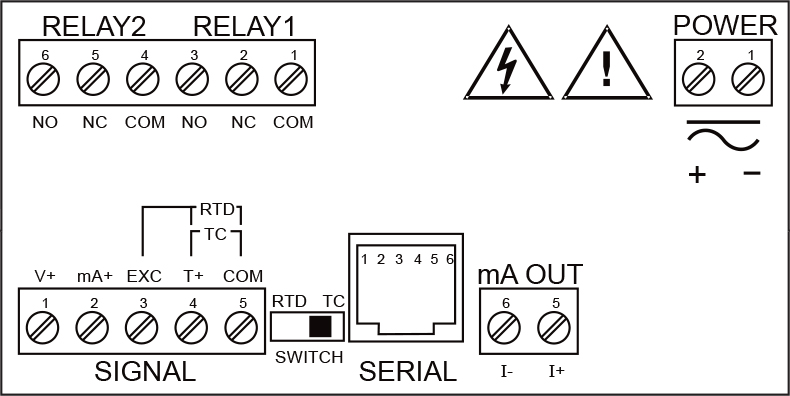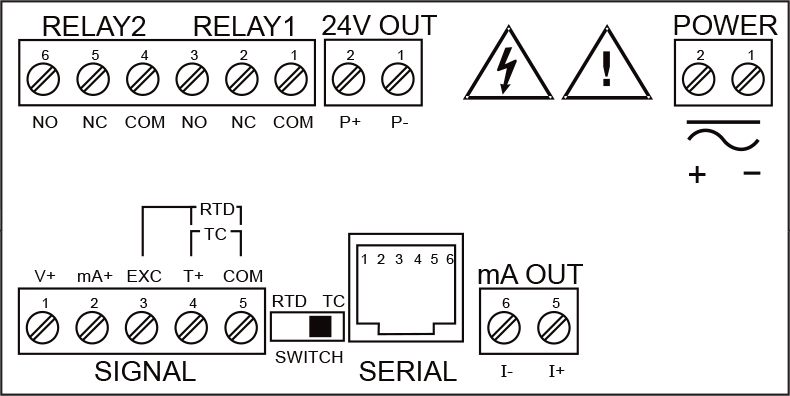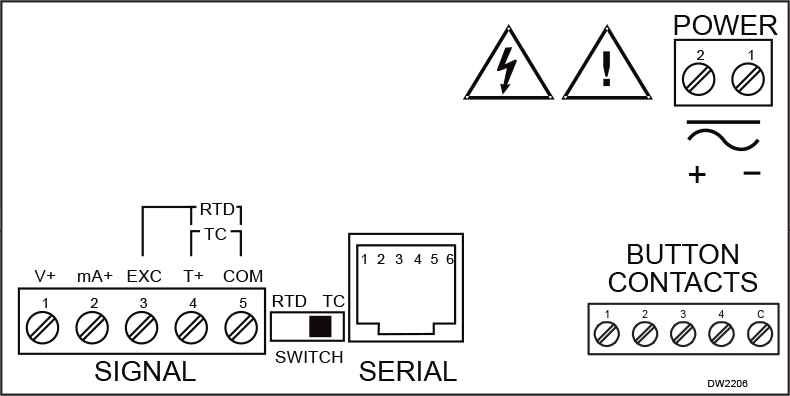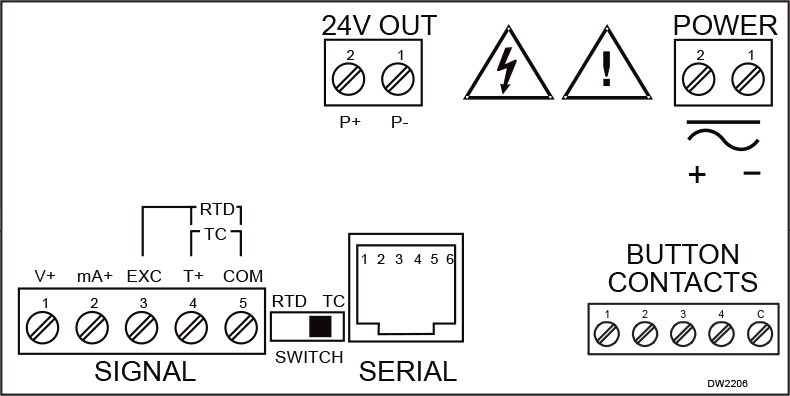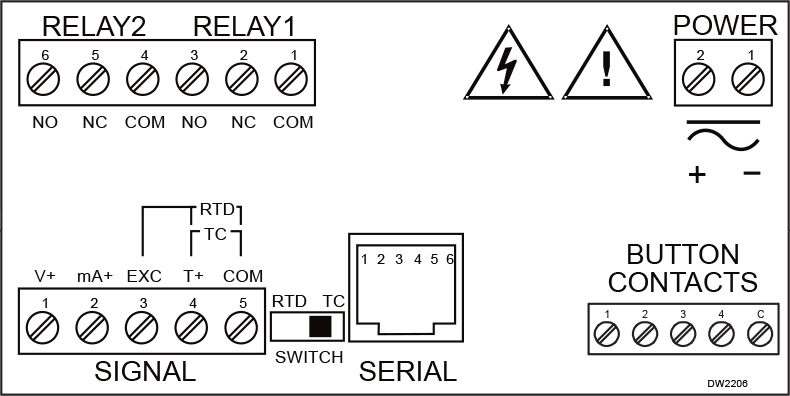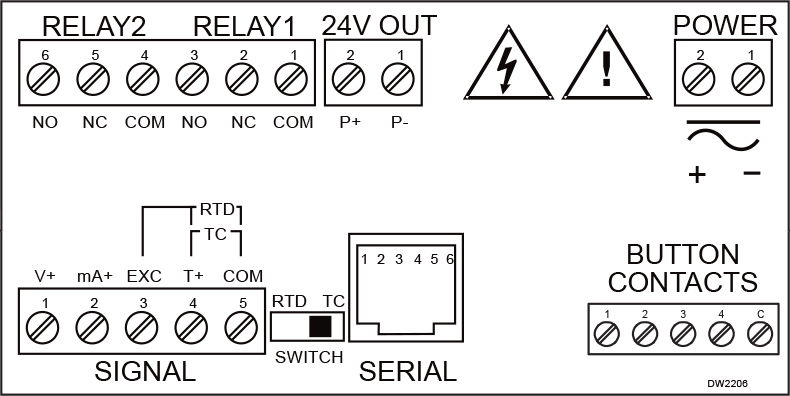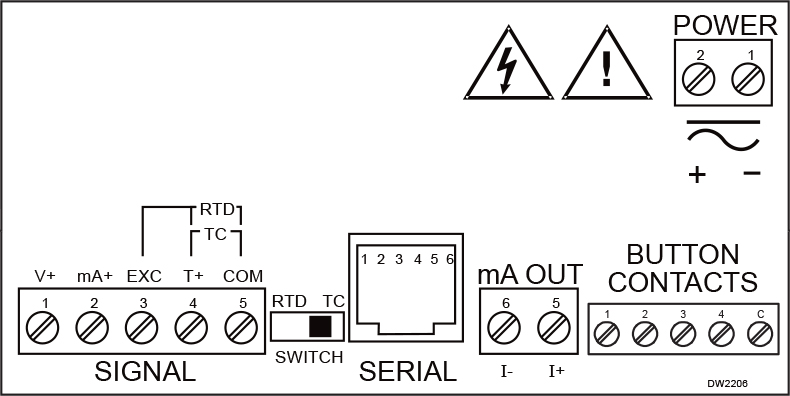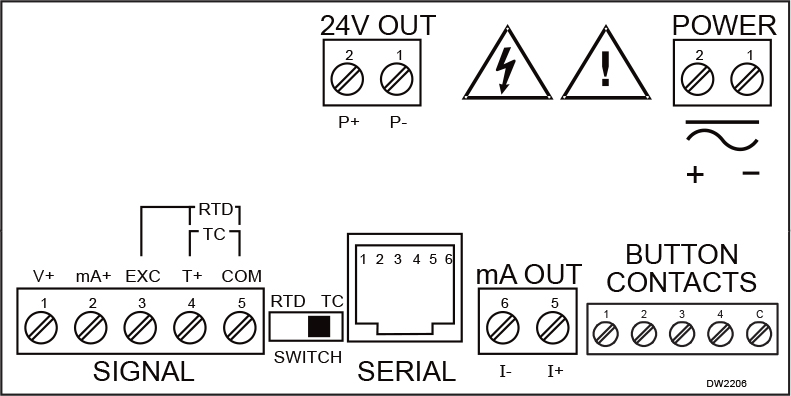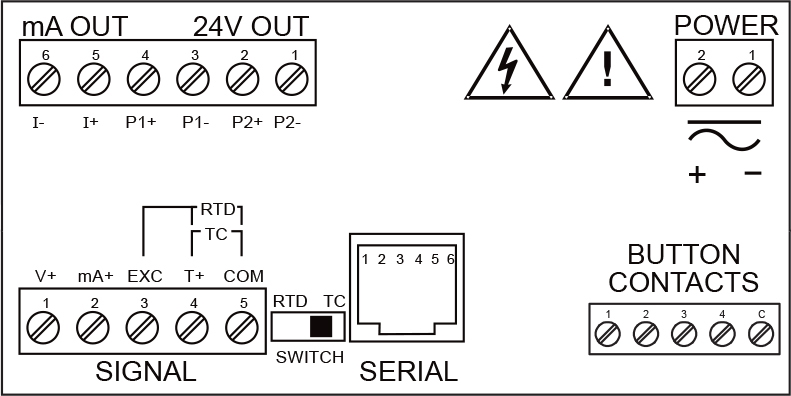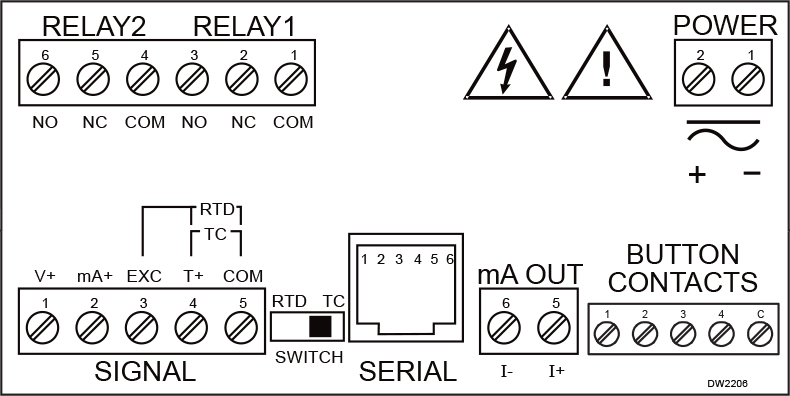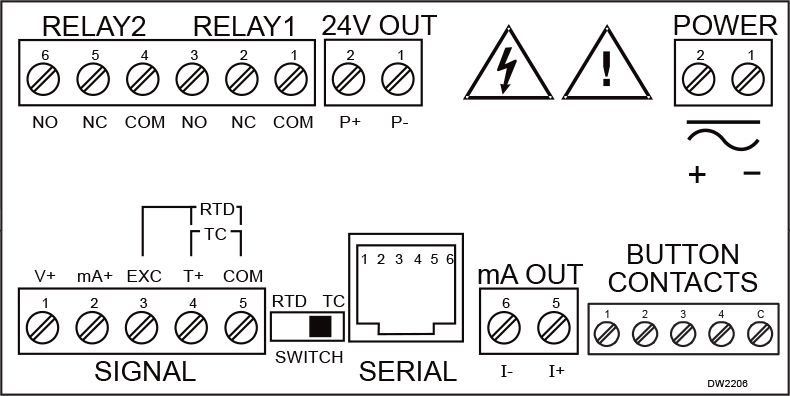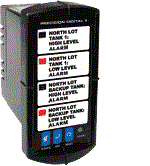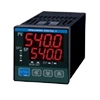Features
- 1/8 DIN Digital Panel Meter with NEMA 4X, IP65 Front
- 4-20 mA, ± 10 V, TC & RTD Field Selectable Inputs
- Easy Field Scaling in Engineering Units without Applying an Input
- Full 4-Digit Display, 0.56" (14.2 mm) or 1.20" (30.5 mm)
- Shallow Depth Case Extends Only 3.6" (91 mm) Behind Panel
- Isolated 24 VDC @ 200 mA Transmitter Power Supply Option (AC Powered Models Only)
- 2 Relays + Isolated 4-20 mA Output Options
- Free PC-Based MeterView Programming & Monitoring Software
- No Assembly Required
- Sunlight Readable Display
- Operating Temperature Range: -40 to 65°C (-40 to 149°F)
- UL & C-UL Listed. E160849; UL 508 Industrial Control Equipment
- Input Power Options: 85-265 VAC / 90-265 VDC or 12-36 VDC / 12-24 VAC
- Duplex Pump Controller with Alternation Capability
- External Contacts for Remote Button Operation (Trident X2 Only)
- USB, RS-232, & RS-485 Serial Communication Adapters Options
- Modbus RTU Communication Protocol Standard
- Copy Meter Settings to Other Trident Meters
- Password Protection
- Max/Min Display
- High & Low Alarms with Multiple Reset Actions
- Wide Assortment of NEMA 4X Enclosures for up to Ten Meters
- Light/Horn & Button Accessory for Trident X2
- Control Station Accessory for Remote Operation of Trident X2
- Stainless Steel Sun Hood Accessory Available
- 3-Year Warranty
Overview
The Only 1/8 DIN Process & Temperature Meter You Will Ever Need
The PD765 Trident digital panel meter is one of the most versatile digital panel meters on the market and will satisfy a wide variety of process and temperature applications. The Trident can be field programmed to accept process voltage (0-5V, 1-5V, etc) and current (4-20 mA) inputs, 100 Ohm RTDs, and the four most common thermocouples.
One of the Trident’s most useful features is its ability to provide 24 VDC to power the transmitter’s 4-20 mA signal. It is housed in a shallow-depth, 1/8 DIN enclosure that features a NEMA 4X front panel and convenient mounting hardware. There are two power options for the Trident: 85 to 265 VAC or 12-36 VDC and the AC powered version can provide 24 VDC to power the transmitter if needed. Programming and setup can be performed with the four front panel pushbuttons, free MeterView software or using the Copy function.
Two relays and isolated 4-20 mA output options increase the utility of the Trident meter. The relays can be used for alarm or control applications. The 4-20 mA output provides an isolated retransmission of the input signal; especially useful for temperature inputs like thermocouples and RTDs.
The display height on the standard Trident meter is 0.56" (14.2 mm) and on the Trident X2 the display height is an astounding 1.2" (30.5 mm). The Trident X2 can be read easily from distances of up to 30 feet!
The intensity of the display on both versions of the Trident can be adjusted to compensate for various lighting conditions, including direct sunlight.
Both meters are available with all Trident features, although only the Trident X2 includes four external button contacts.
Front
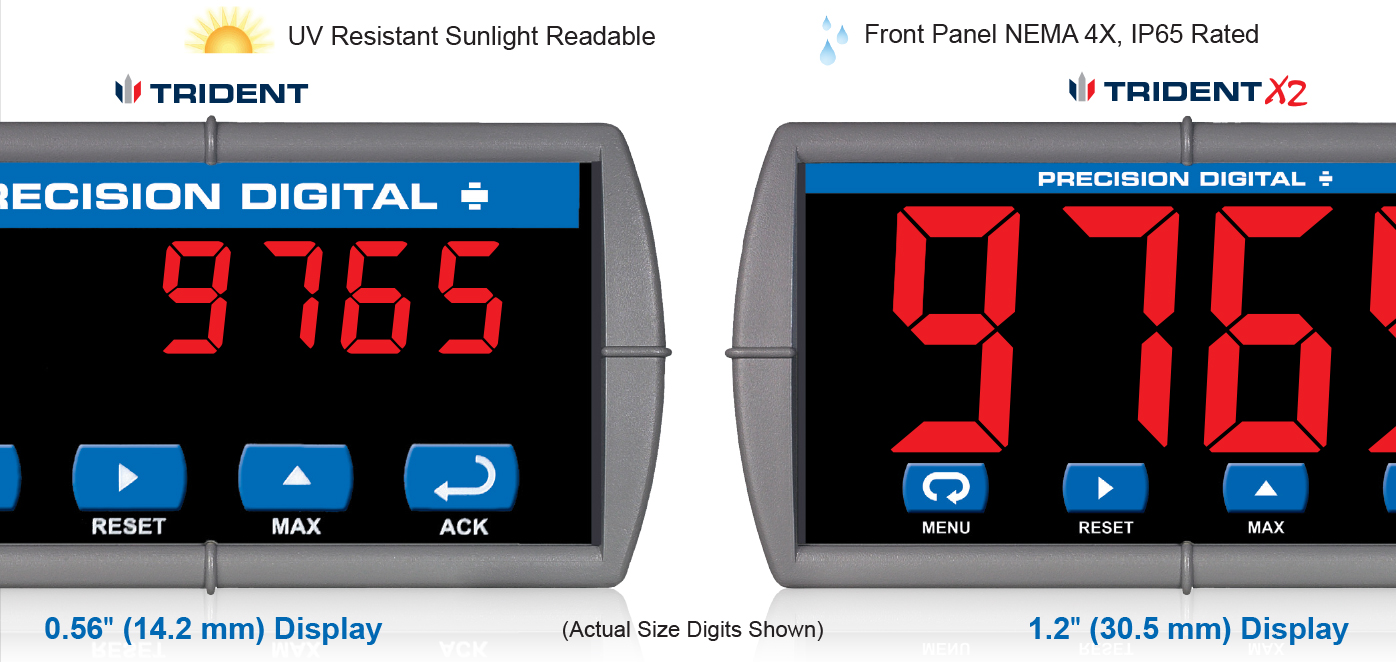
Trident and Trident X2 Connections (rear view)
PD765-6R5-10 (Trident)
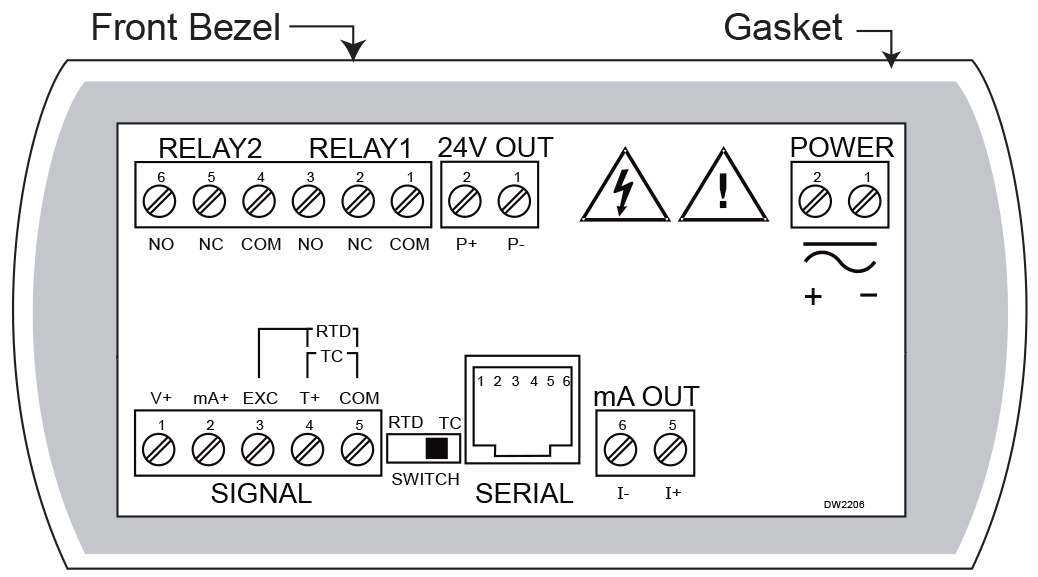
Two SPDT relays; 24 V transmitter power; TC, RTD, 4-20 mA or 0-10 VDC inputs; 4-20 mA output
PD765-6X5-10 (Trident X2)
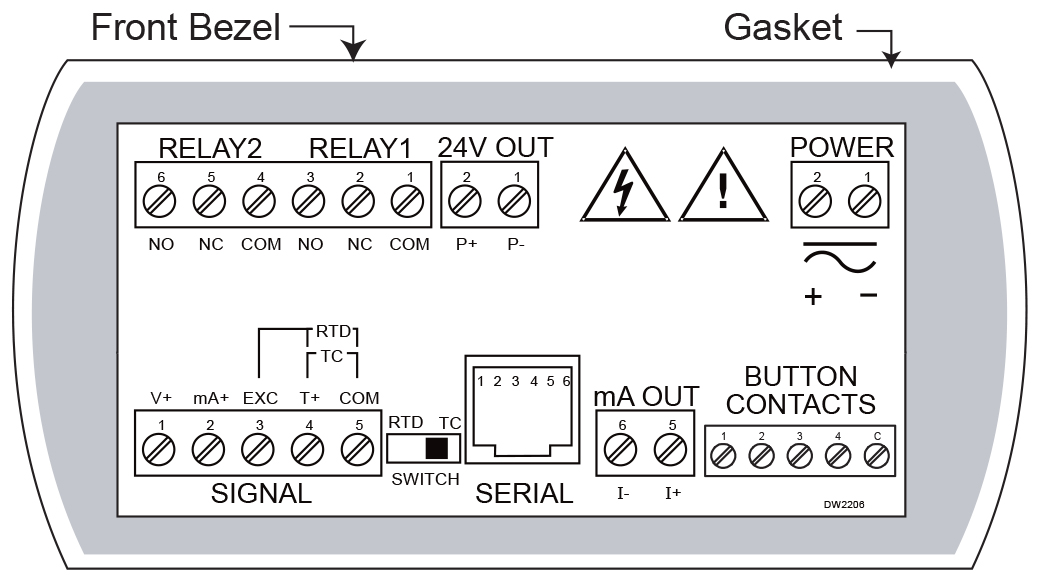
Two SPDT relays; 24 V transmitter power; TC, RTD, 4-20 mA or 0-10 VDC inputs; 4-20 mA output; four external button contacts
Advanced Display Features
Four Full Digits
The display on the Trident is four full digits which means it can display numbers up to 9999. Many digital panel meters have displays of only 3½ digits which means they can display only to 1999. In practical terms, this means the Trident can display type K thermocouples to 2300ºF and 4-20 mA signals up to 9,999.
Front Panel LEDs
The meter is supplied with two alarm points that include front panel LEDs to indicate alarm conditions. This standard feature is particularly useful for alarm applications that require visual-only indication.
Two Display Sizes
The display height on the standard Trident meter is 0.56" (14.2 mm) and on the Trident X2 the display height is an astounding 1.2" (30.5 mm). The Trident X2 can be read easily from distances of up to 30 feet!
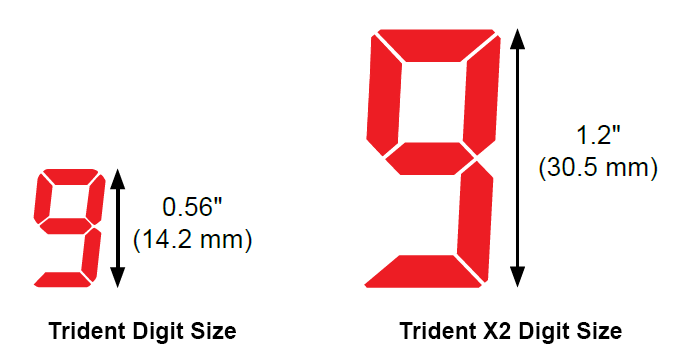
Sunlight Readable Display
The intensity of the display on both versions of the Trident can be adjusted to compensate for various lighting conditions, including direct sunlight. In the advanced menu features menu, you can choose from eight levels of intensity depending on the visibility conditions.
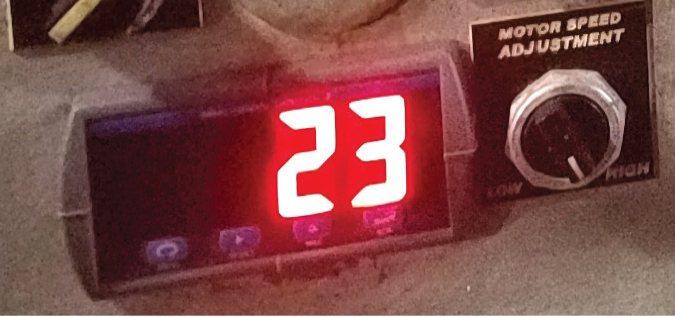
The following diagram illustrates how to set the intensity on the Trident process and temperature meter:
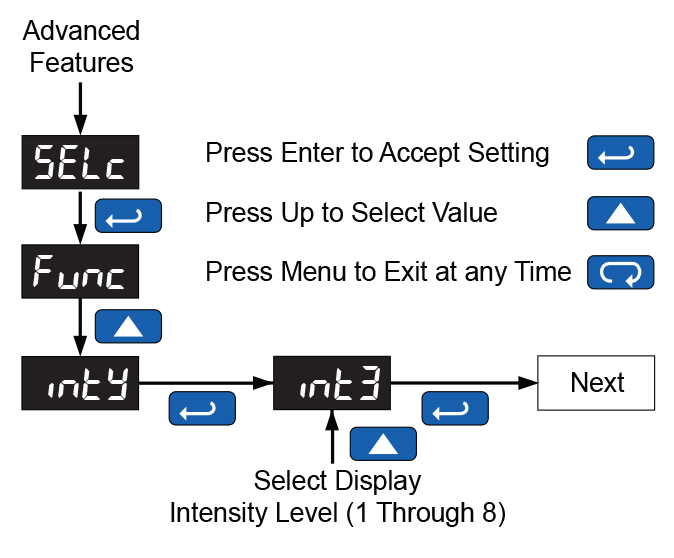
Display & Toggle Maximum / Minimum Reading
The main function of the front panel buttons during operation is to display the maximum and minimum readings reached by the process or temperature inputs. The Trident allows you to toggle between the maximum and minimum readings of the process values. To display the maximum and minimum readings since the last reset/power-up, use the Up arrow/Max button.
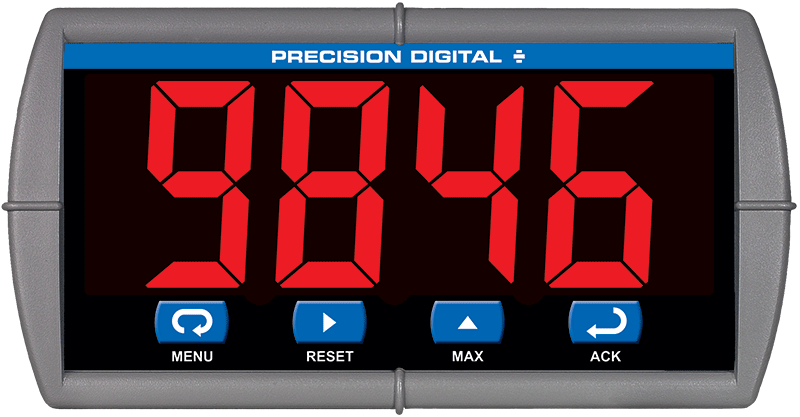 Display & Toggle Maximum Value
Display & Toggle Maximum Value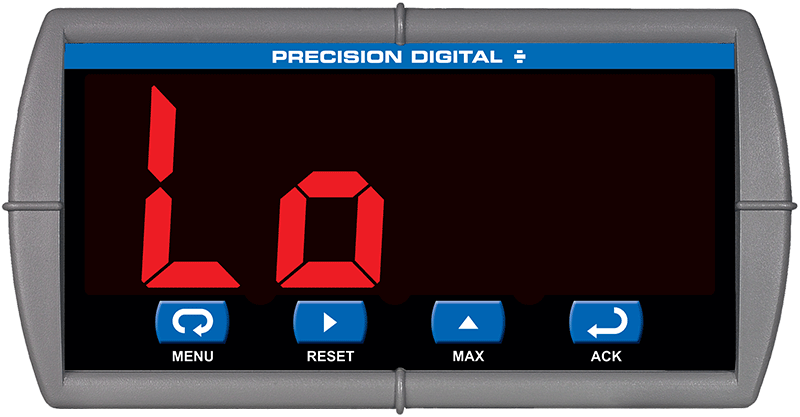 Display & Toggle Minimum Value
Display & Toggle Minimum ValueThe PDA18DINSH Sun Hood improves the readability of 1/8 DIN digital panel meters when they are mounted in direct sunlight by shading the instrument from the sun.
The Sun Hood is made from 18 gauge 316 stainless steel and mounts between the 1/8 DIN digital panel meter and the panel. In addition, a gasket is provided that installs between the Sun Hood and the panel to provide a NEMA 4X seal to the panel. The whole assembly is held in place by the panel meter’s mounting brackets.
- Provides Shade for 1/8 DIN Digital Panel Meters
- Made from 18 Gauge 316 Stainless Steel
- Easy Mounting Requires No Drilled Holes in the Panel
- Includes Gasket to Maintain NEMA 4X Seal
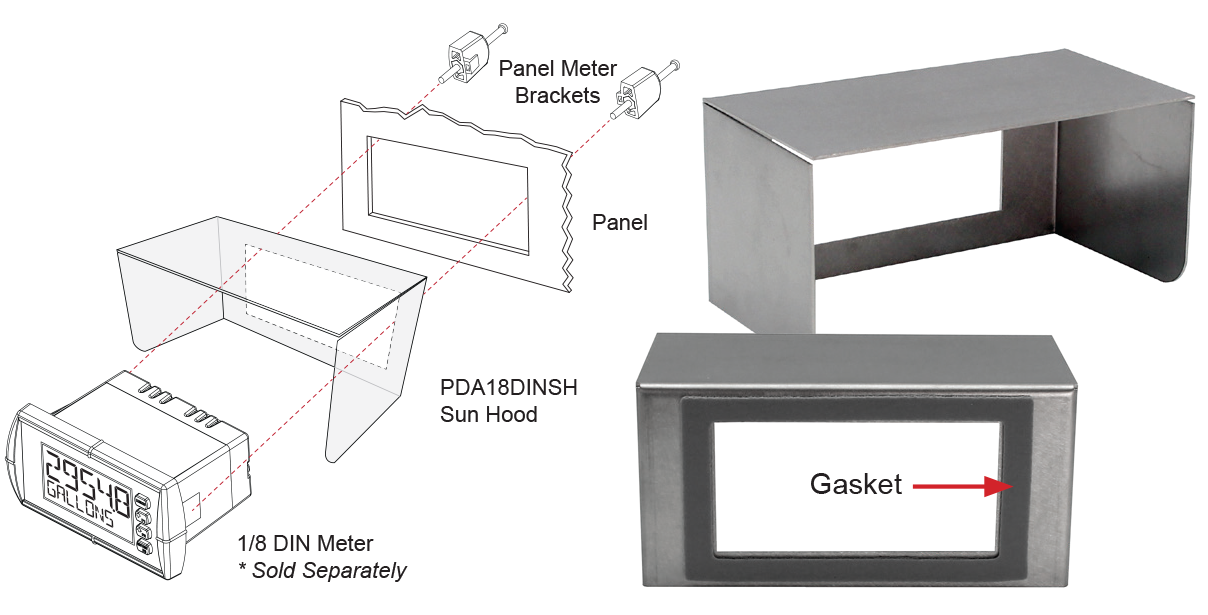
Process & Temperature Inputs
The Trident is factory calibrated to accept 4-20 mA, ±10 VDC, type J, K, T, or E thermocouples and 100 Ω platinum RTDs. Process inputs can be scaled with or without applying an input for virtually any engineering units. Temperature inputs can be programmed to display in degrees Fahrenheit or Celsius and the type K thermocouple can display up to 2300°F.
Current & Voltage Inputs
Setting up the meter to accept a current or voltage input could not be easier. All setup is performed with the front panel buttons and there are no switches or jumpers to deal with.
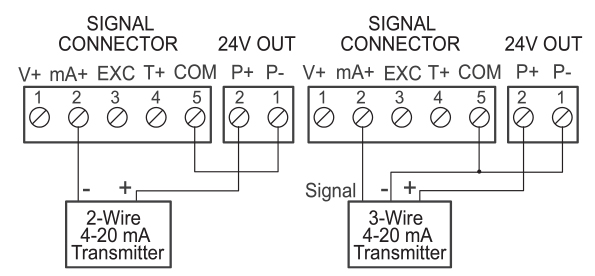
Transmitter Powered by Internal Supply (optional)
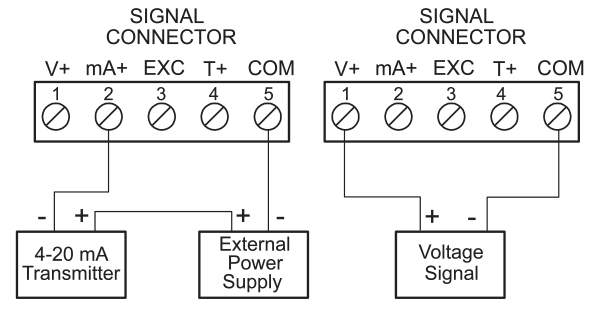
Transmitter Powered by External Supply
Current Overload Protection
To protect the instrument from unexpected current overload, the current input circuit contains a resettable fuse. The fuse limits the current to a safe level when it detects a fault condition, and automatically resets itself when the fault condition is removed.
Thermocouple & RTD Inputs
Setting up the Trident to accept a thermocouple or RTD input is simply a matter of setting a switch at the rear of the case and selecting the input type from the menu. The meter accepts J, K, T, or E type thermocouples as well as two, three, or four-wire 100 Ω platinum RTDs.
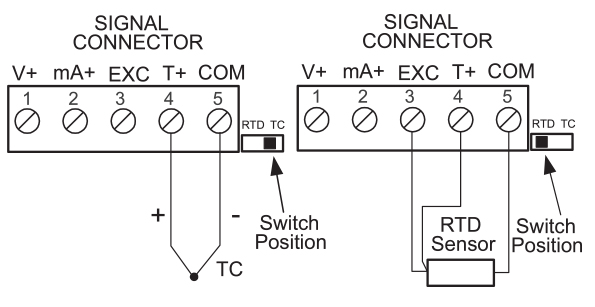
Temperature Inputs
The Trident meter accepts J,K,T or E thermocouples and 100 Ω platinum RTDs. For the T thermocouple and RTD, the user can display temperature to 1° or 0.1° resolution and the Type K thermocouple to 2300ºF. In addition, these meters will operate down to -40°C with only mininal loss of accuracy.
| Type | Range | Acc (0-65°C) | Acc (-40-0o°C) | Resolution |
| J | -58° to 1382°F -50° to 750°C | ±2°F ±1°C | ±5°F ±3°C | 1° |
| K | -58° to 2300°F -50° to 1260°C | ±2°F ±1°C | ±4°F ±2°C | 1° |
| T | -292° to 700°F -180° to 371°C | ±2°F ±1°C | ±13°F ±7°C | 1° or 0.1° |
| E | -58° to 1700°F -50° to 927°C | ±2°F ±1°C | ±11°F ±6°C | 1° |
| RTD | -328o° to 1382°F -200° to 750°C | ±1°F ±1°C | ±5°F ±3°C | 1° or 0.1° |
Display Flow Rate From a DP Transmitter
DP Flow via Square Root Extraction
In this application, the PD765 is displaying flow rate by extracting the square root from the 4-20 mA signal from a differential pressure transmitter. The user selectable low-flow cutoff feature gives a reading of zero when the flow rate drops below a user selectable value.
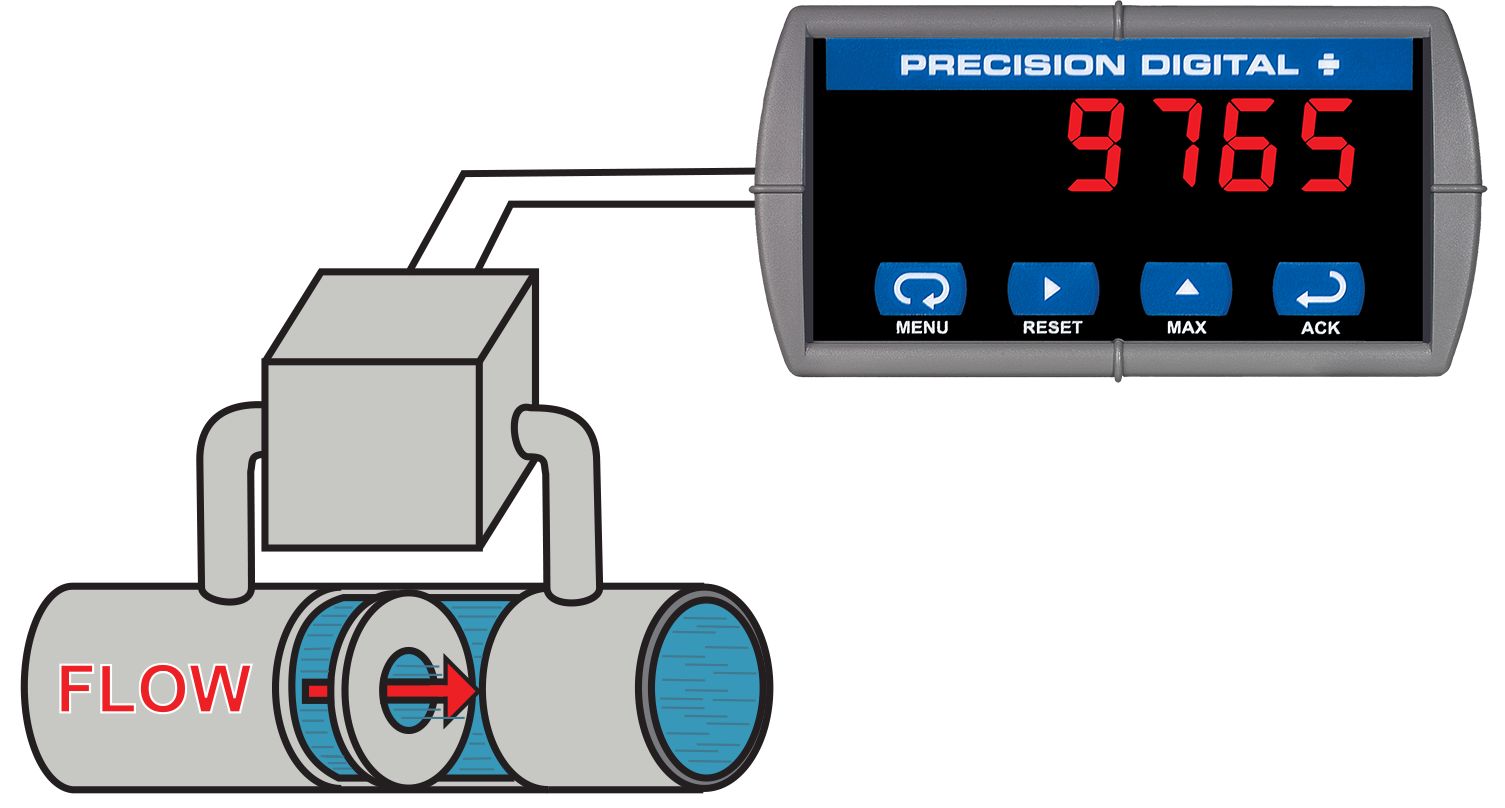
Isolated Transmitter Power Supplies
24 V @ 200 mA Transmitter Power Supply
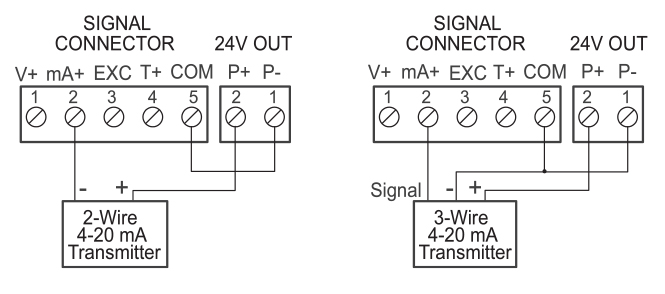
One of the most useful features of the Trident PD765 when it is AC powered is its built-in, isolated, 24 V @ 200 mA power supply to power the transmitter. This feature saves money by eliminating an external power supply and also simplifies wiring.
24 V @ 40 mA 4-20 mA Output Power Supply
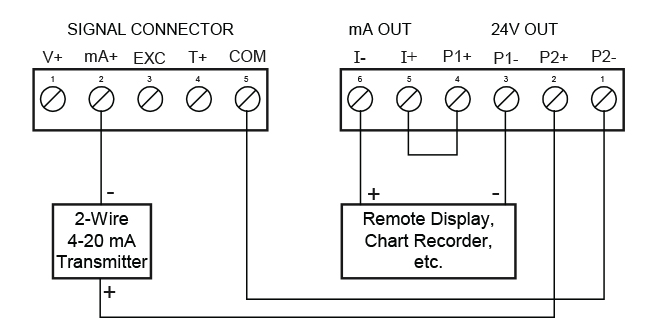
Not only can the AC powered PD765's power the 4-20 mA input signal, but an additional power supply of 24 V @ 40 mA is available on select models to power the 4-20 mA output.
Resettable Fuse Prevents Current Overload
Another very useful aspect of the Trident is that the current input is protected against current overload by a resettable fuse. The fuse limits the current to a safe level when it detects a fault condition, and automatically resets itself when the fault condition is removed.
Isolated 4-20 mA Transmitter Output
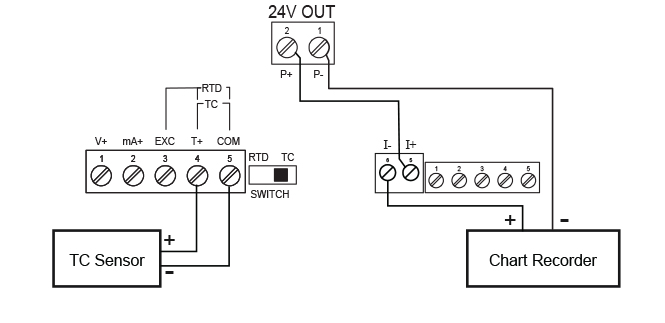
The Trident's isolated 4-20 mA output option converts the Trident into a transmitter / loop isolator with a digital display; perfect for temperature applications!
Other Uses for Transmitter Power Supplies
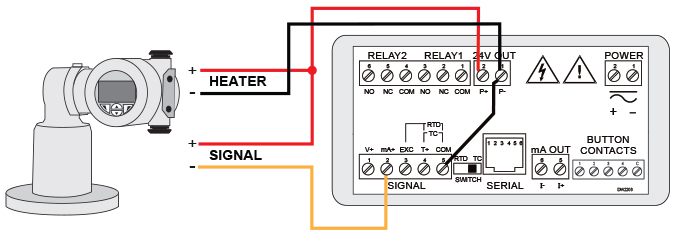
The most common use for these two power supplies is for the 200 mA transmitter power supply to power the field transmitter and 40 mA power supply to power the 4-20 mA output from the meter. However, these two power supplies can be used in other ways. For instance, some level transmitters require the use of a heated lens. The Trident’s 200 mA power supply could be used to power both the heated lens and the 4-20 mA signal from the transmitter.
External Power Supply for the Loop
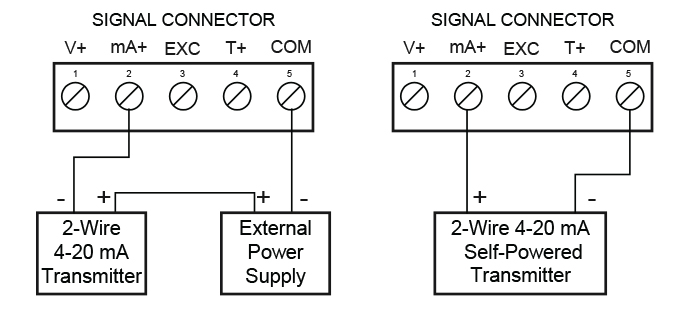
For applications that require an external transmitter power supply, the same Trident is used and merely wired in a different fashion as the above diagrams illustrate.
4-20 mA Output & Relays
Isolated 4-20 mA Analog Output
There are several uses for the Trident’s isolated 4-20 mA
output. For temperature applications, the isolated 4-20 mA
output option turns the Trident X2 meter into a temperature
transmitter with a huge display! For 4-20 mA input applications
the isolated 4-20 mA output turns the Trident meter into a signal
isolator with the convenience of local display of the process
variable. The 4-20 mA output can also be reversed scaled.
Linear 4-20 mA Analog Output
For applications where the input was linearized by the Trident, the 4-20 mA output will represent that linearized value.
Convert Temperature Inputs to 4-20 mA Output with the PD765
The Trident X2, with the appropriate options, can be used as an isolated temperature transmitter with a big display by converting the thermocouple or RTD input into an isolated 4-20 mA output.
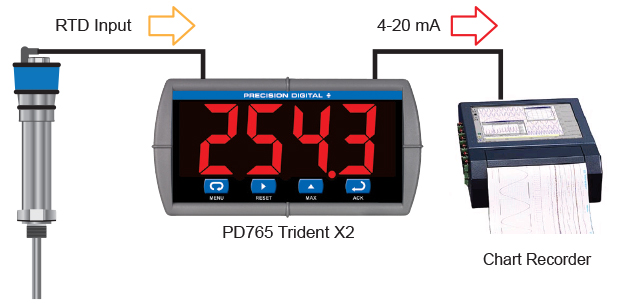
The 4-20 mA output can be reversed scaled such that 4 mA represents the high value and 20 mA represents the low value. For instance, a 4-20 mA output signal could be generated as the meter went from 100.0 to 0.0.
PD765 Provides 500 V of Isolation on the Output
The inputs and outputs of the PD765 Trident are electrically isolated to prevent ground loops and make wiring easier. All inputs, outputs and power supplies are fully isolated from one another.
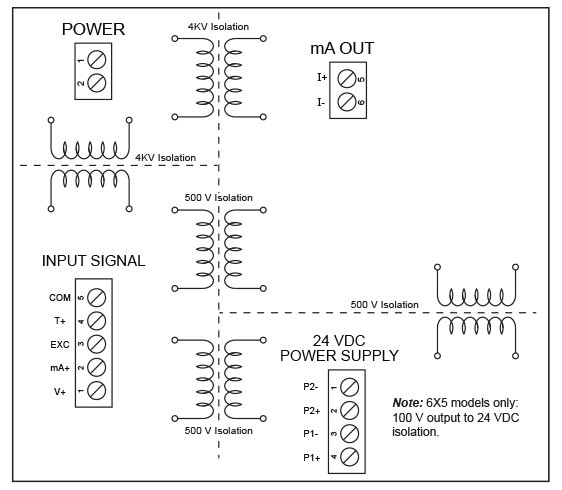
Connections
AC powered versions of the Trident can provide 40 mA at 24 VDC to power the 4-20 mA output signal or an external power supply can be used:
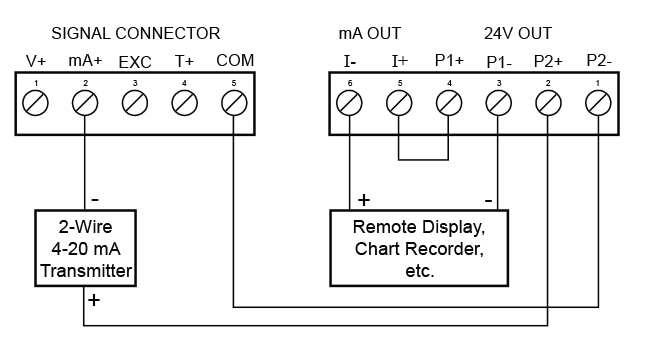
4-20 mA Output & Input Signal Powered by Meter
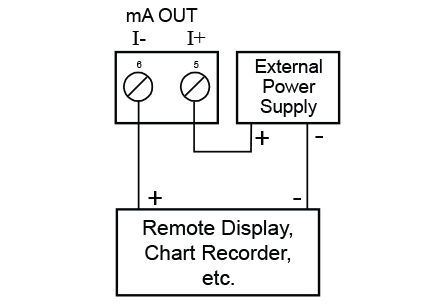
4-20 mA Output Powered Externally
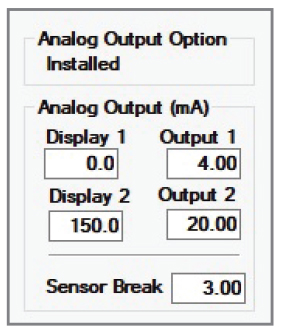
When a meter is programmed as shown to the left, the output will be 4.00 mA when the display reads 0.0 and the output will be 20.00 mA when the display reads 150.0.
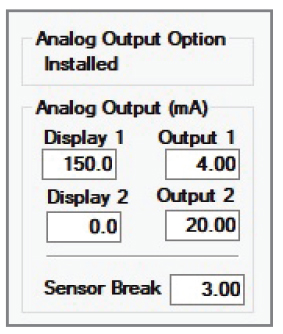
The meter can be set up for reverse scaling as shown to the left: the output will be 4.00 mA when the display reads 150.0 and the output will be 20.00 mA when the display reads 0.0
Sensor Break: Analog output value when TC or RTD sensor break is detected.
Relays for Alarm & Control Applications
Adding relays to the Trident meter turns it into a sophisticated alarm device as well as a powerful, yet simple, alternative to a more complicated PLC system for control applications. One such application would be pump control using the Trident’s relays in pump alternation mode. The Trident can be equipped with two 3 A Form C (SPDT) internal relays. The relays are highly user-configurable as the following screen shot from MeterView indicates:
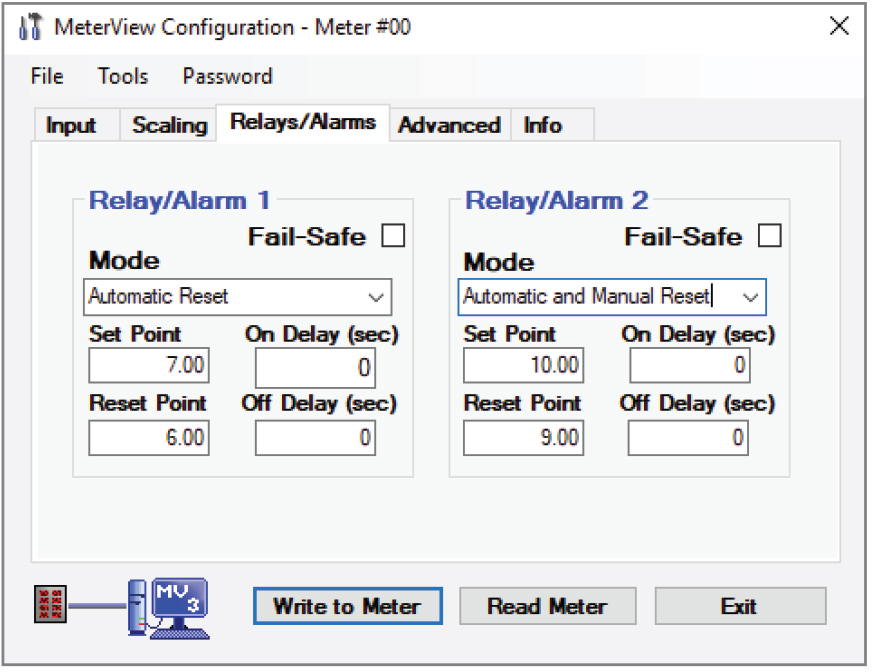
- Program Set and Reset Points (HI / LO Alarms)
- Reset the Relays (Mode in MV)
- Time Delay (On and Off)
- Relays Auto Initialization
- Signal Loss Relay Operation (Sensor Break)
- User Selectable Fail-Safe Operation
Relay connections are made to a six-terminal connector labeled RELAY1 and RELAY2.

Pump Controller with Dual-Pump Alternation
The PD765 can be used as a low-cost pump controller when combined with a continuous level transmitter. One of the most common pump control application is shown below: controlling and alternating two pumps. The goal is to control the level between 1000 and 6000 gallons. The main pump turns on when the level reaches 6000 gallons and pumps down to 1000 gallons and then shuts the pump off. The next cycle, the backup pump turns on at 6000 gallons and shuts off at 1000 gallons. If at any time the active pump can’t keep the level below 7000 gallons, the other pump would come on also.
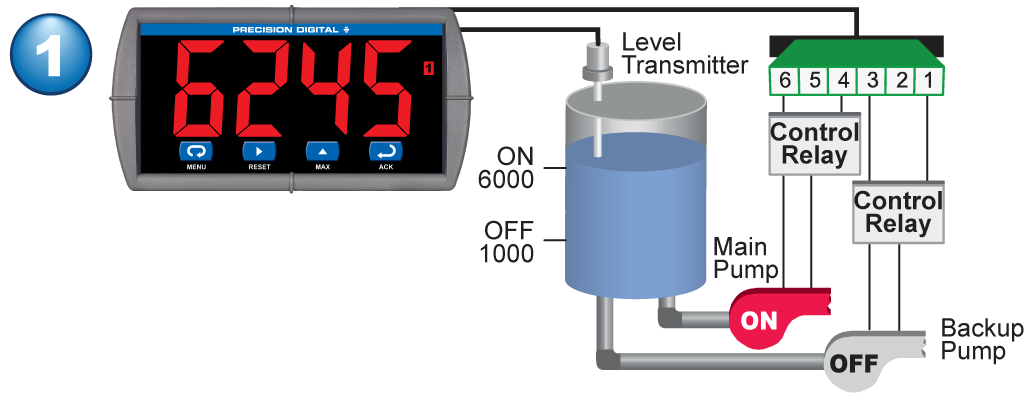
Relay #1 turns the main pump on at 6000 gallons and turns it off at 1000 gallons.
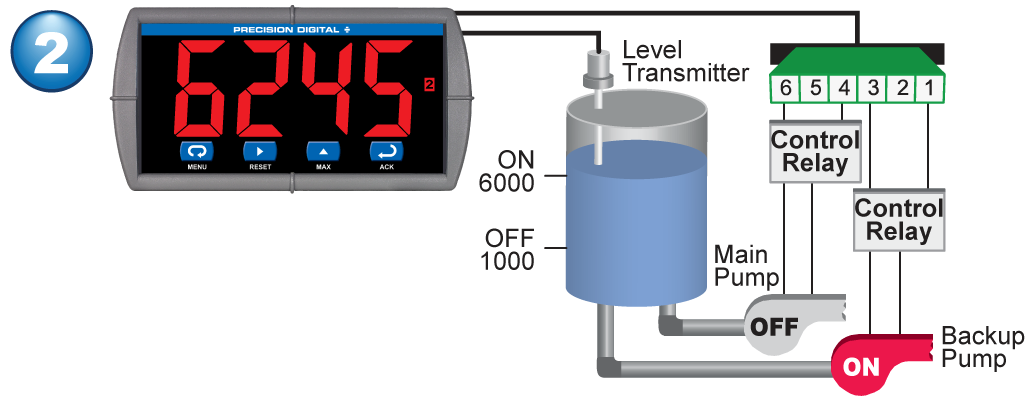
With the Pump Alternation feature activated, the next time the level reaches 6000 gallons relay #2 starts the backup pump.
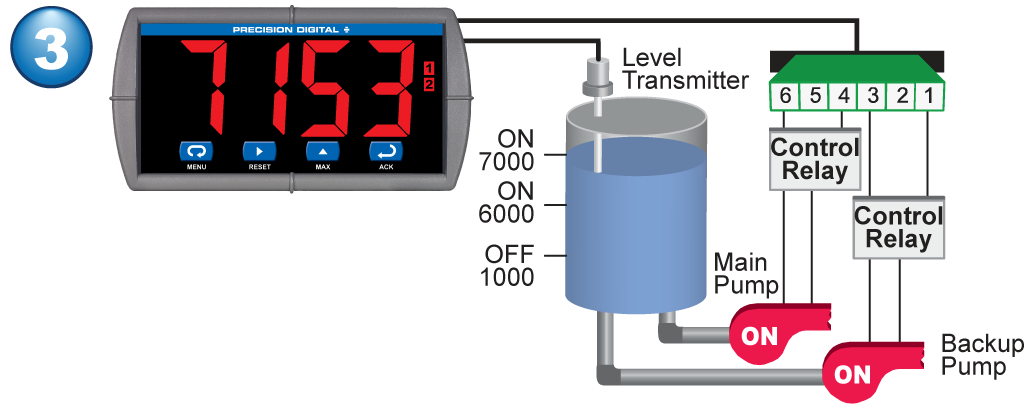
If the active pump is not able to keep up, and the level reaches 7000 gallons, the other relay will start the inactive pump as well.
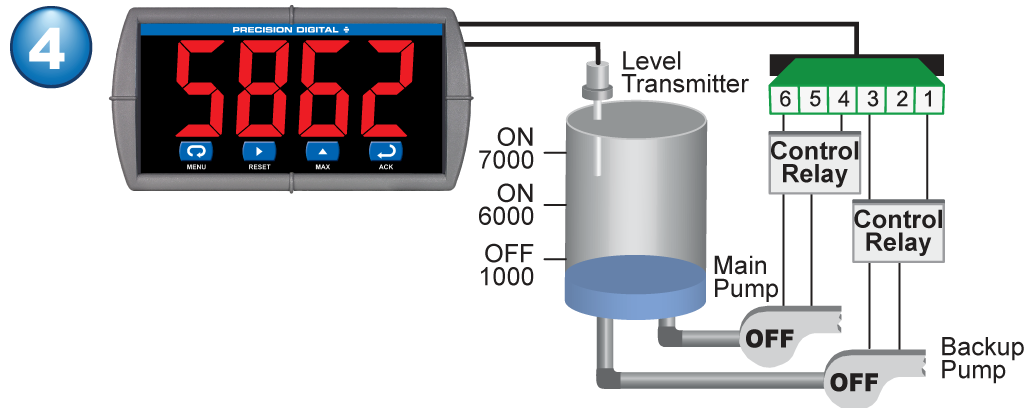
When the level falls below 1000 gallons both pumps will turn off.
Physical Features
The PD765 Trident is designed for ease-of-use in industrial applications. It is housed in a shallow depth case and includes a NEMA 4X front panel, wide operating temperature range, removable screw terminal connectors, snap in place mounting brackets, forgiving panel cutout requirement, and UL Listing for electrical safety. All of these features are backed by a 3-year warranty.

Wide Operating Temperature Range
The Trident can operate from -40 to 65°C (-40 to 150°F) meaning it can be installed in a wide variety of indoor and outdoor industrial applications. And over this range, the Trident will drift no more than 0.005% of calibrated span/°C max from 0 to 65°C ambient and 0.01% of calibrated span/°C max from -40 to 0°C ambient.
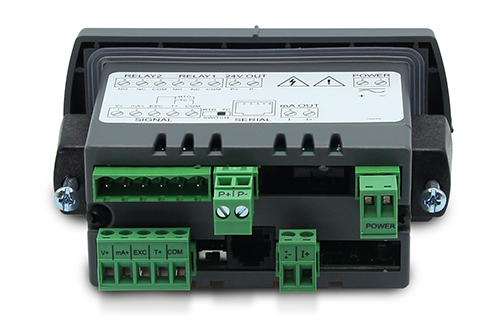
Removable Screw Terminal Connectors
Industrial applications require screw terminal connections for easy field wiring and the Trident goes one step further in convenience by making them removable also.
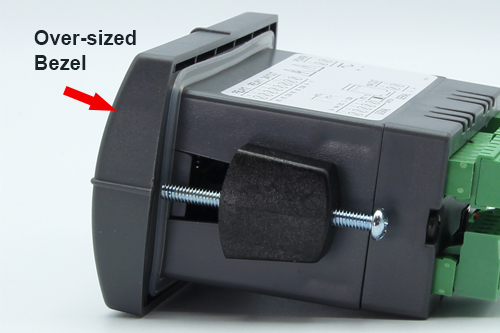
Forgiving Panel Cutout Requirement
The Trident's bezel has been oversized to allow for not perfectly executed panel cutouts where NEMA 4X seal is not required.
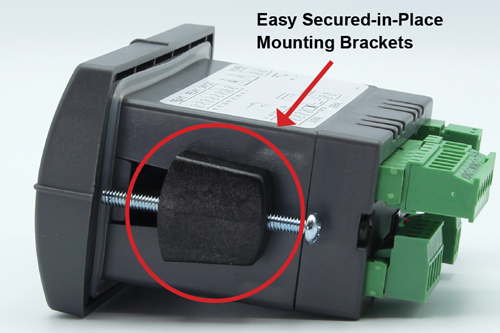
Secured-in-Place Rugged Mounting Brackets
If you’re installing the Trident outdoors in the hot or cold weather, the last thing you want to do is fumble around with mounting brackets that don’t stay in place. The Trident's mounting brackets can be easily secured into place and then screwed down to the panel. These brackets are rugged so they can be tightened to the panel to provide a solid NEMA 4X seal.
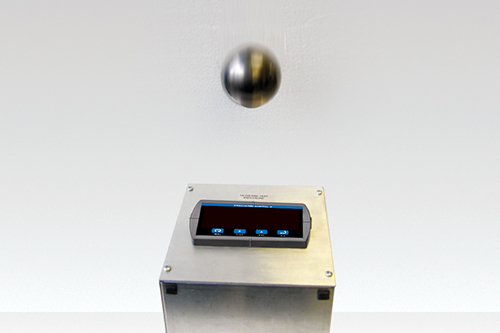
Type 4X / NEMA 4X Front Panel
Not only does the Trident’s front panel UL Type 4X approval indicate it is waterproof, but it also indicates it is rugged. Part of the UL Type 4X test is to drop a 2-inch solid stainless steel ball from 8 feet on top of the meter’s faceplate.
Operational Features
Three Front Panel Button Operations
The main function of the front panel buttons during operation is to display the maximum and minimum readings reached by the process or temperature inputs as well as acknowledge relays.
The following buttons can perform these functions:

External Button Contacts Available on Trident X2
The Trident X2 is equipped with four external button contacts that can be used to remotely operate the Trident X2’s frontpanel buttons.
For instance, these button contacts can be used to program the meter and to remotely acknowledge/reset the relays:

The external button contacts are particularly useful for wiring up a remote button to reset the relays as shown here:

Plastic Control Stations for Trident X2
The PDA2360 series of plastic control stations provide a convenient way to remotely program the Trident X2 meter via its four external button contacts. In addition, they also provide a means to acknowledge the relays with a remotely mounted button.
- Complete Pre-Assembled Stations
- Normally Open (NO) Spring Return Plastic Bezel Pushbuttons
- Trigger Action Turn to Release Pushbutton (PDA2360-E only)
- Control Station for Remote Operation of Light/Horn Button
- IP65 / NEMA 4, 4X and 13 Rated
- Wall Mountable
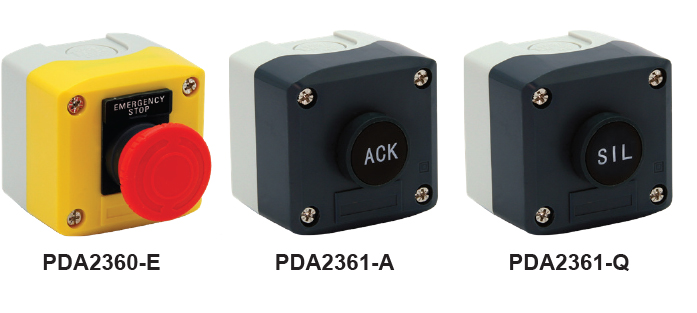
| PDA2360 Series Control Stations | |
| Model | Description |
| PDA2360-E | Emergency Stop Button |
| PDA2361-A | 1 Black Ack Button |
| PDA2361-Q | 1 Black Silence Button |
| PDA2364-MRUE | 4 Black Buttons: Menu, Right, Up, Enter |
Four-Position Control Station for Remote Operation of Trident PD765 X2 Buttons
The Trident PD765 X2's four programming and operations buttons can be remotely controlled by using the PDA2364-MRUE 4-button control station accessory as shown in the diagram below.
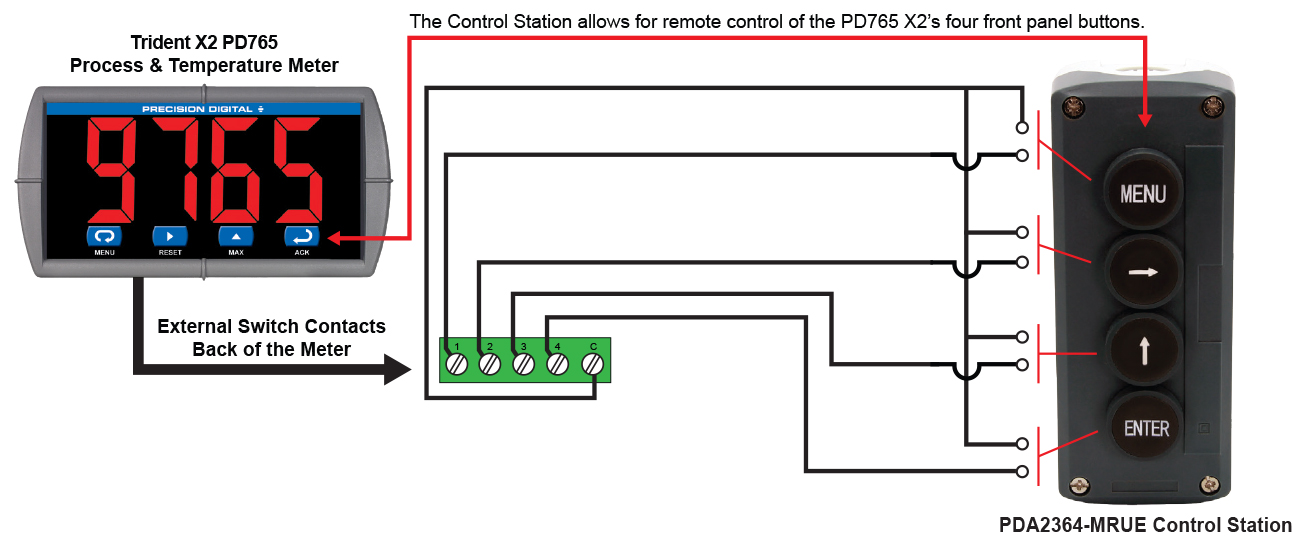
Light/Horn & Button Mounted to Enclosure
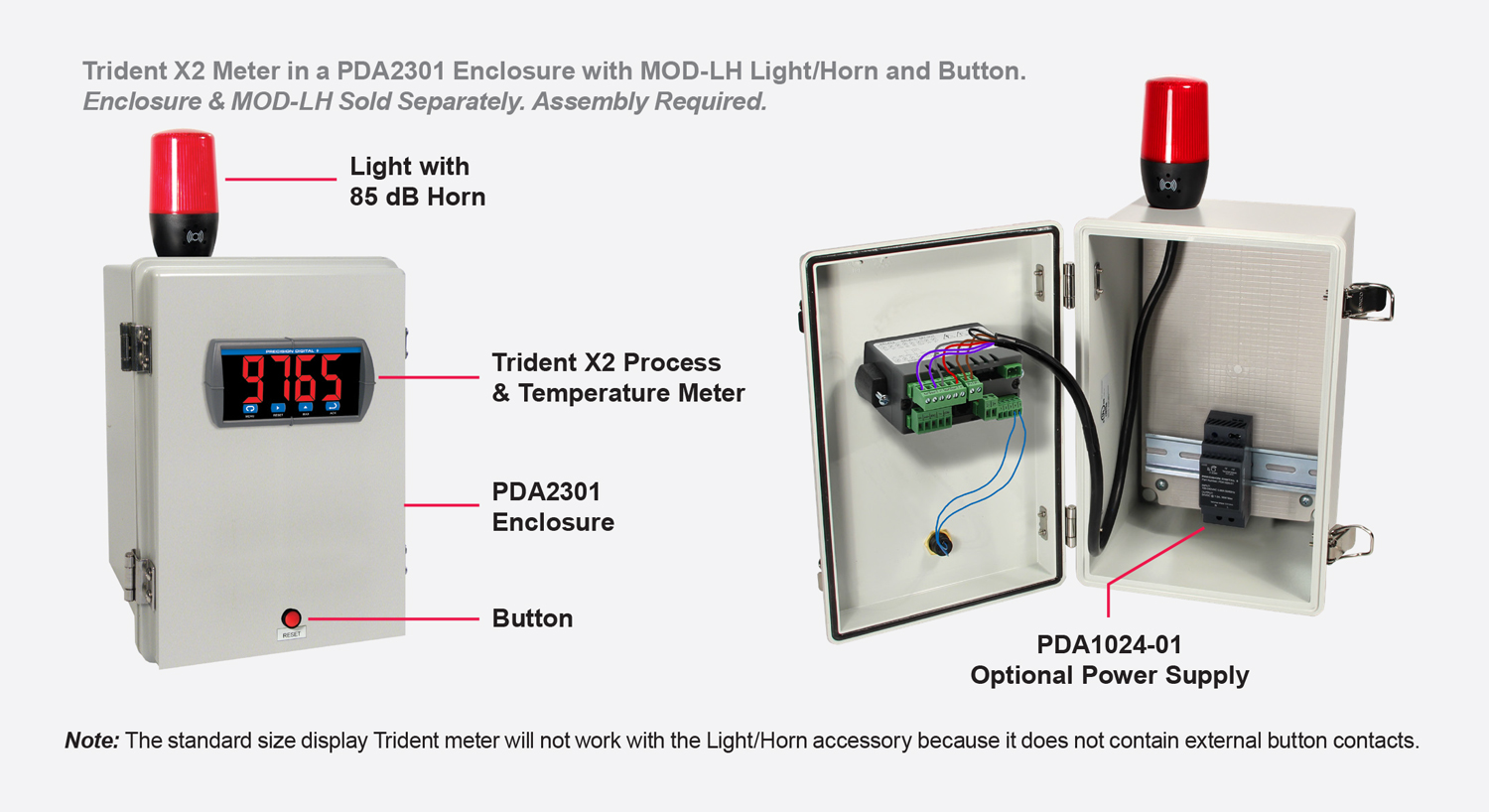
Precision Digital offers a wide variety of NEMA 4 and NEMA 4X enclosures that can be equipped with MOD-LH Light/Horn and Button. When MOD-LH is ordered, the accompanying enclosure on the order comes with the holes pre-drilled for the Light/Horn and the Button and the user performs the mounting and wiring. Meter and enclosure are sold separately. The Light/Horn and the Button can also be ordered as separate items and the user performs all holedrilling, mounting and wiring as desired.
The light and horn can be controlled independently of each other via separate relays on the Trident X2 meter; and since the meter's relays can be reset in a variety of ways, there are several ways the Light/Horn option can operate. For instance, the horn can be programmed to silence at any time via the Button or front panel button on the Trident X2, and light to reset automatically when the alarm clears as the following table illustrates:
| Relay # | Connected to | Default Reset Mode |
| 1 | Flashing Light(1) | Auto reset |
| 2 | Horn | Silence with Button at any time |
- Light can be wired to flash or stay steady on
- See manual or data sheet for additional ways the relays can be programmed
Note: The Light / Horn accessory is powered from the 200 mA transmitter power supply; so when it is installed, there is less power available for the transmitter. See MOD-LH Light / Horn, Transmitter Power Supply specification in the manual or data sheet for details.
Light/Horn Dimensions
Units: Inches (mm)
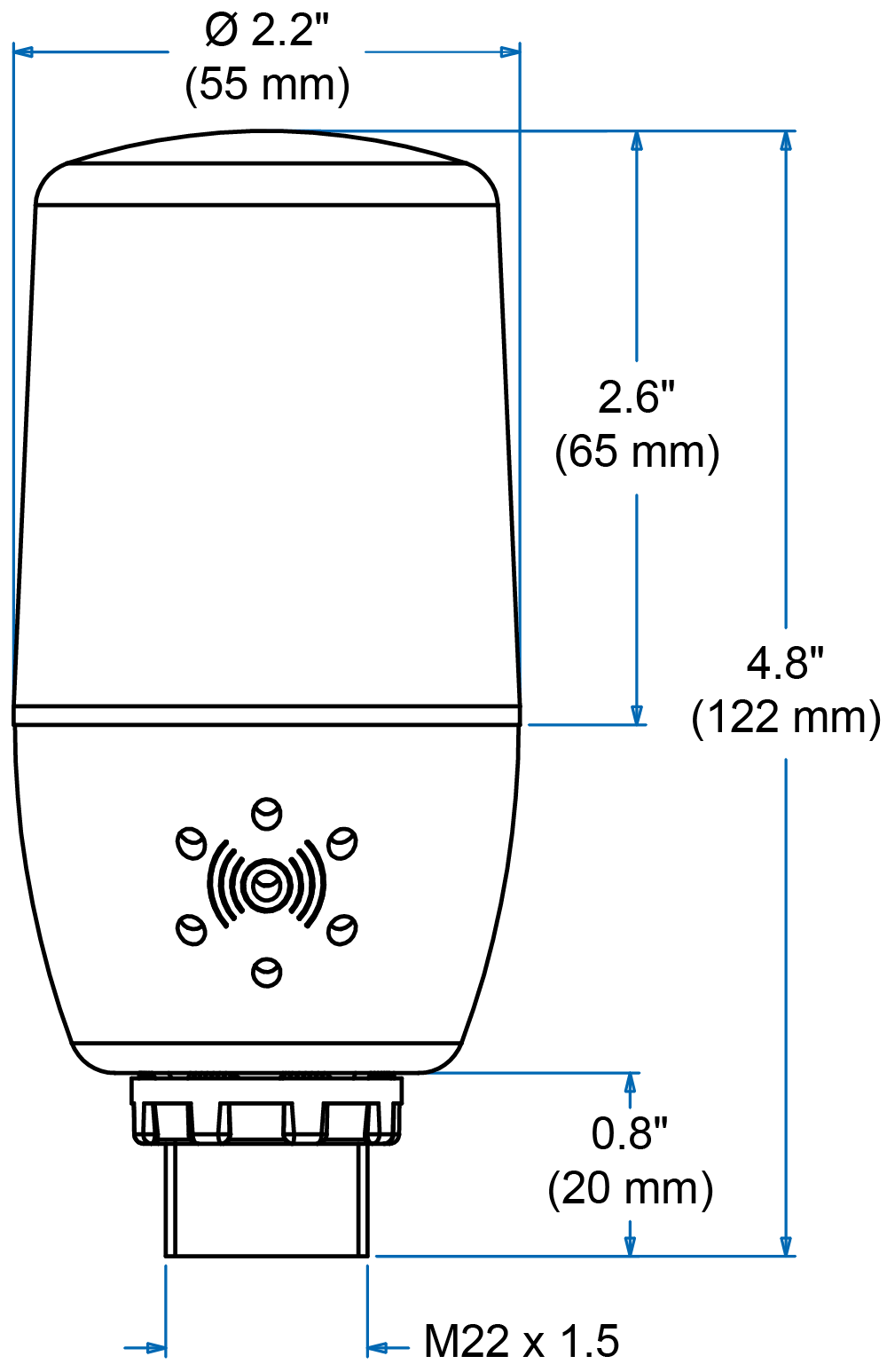
What's Included
Light/Horn
Button and 9 Labels
Hole Drilling on Enclosure
Meter
Enclosure
Installation and Wiring
⚠ Meter and enclosure sold separately. User installation and wiring required.

